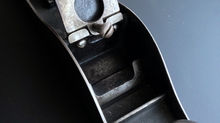To Restore or Not to Restore? That is the Question




So, you just bought yourself a new Stanley No 5 Type 11 at a junk store for 10 bucks. It's all there but it is sad shape. It could be made usable with a little bit of effort...cleaning, flatening and sharpening the iron, you know, the common stuff. But what you really want is to make it "pretty". It always feels so much better when you have a plane that's not only usable but looks nice too.
Collectors are a varied and sometimes funny group of folks. Some would spend $50, $100, $500, $1000 or more on a fine old collectable relic that looks just that. Crusty rusty, gunky, barely recognizable from its origins and leave it just the way they found it, believing it next to a sin to change its appearance just one iota. Then it goes into the old box placed on a shelf and left there usually until the collector, or his/her heirs find it ten years later and try to figure out how much it's worth and how to get rid of it.
On the other hand there are those in the group that do a restoration of sorts to bring out the beauty and original look and feel of a 125 year old plane. They do some minor restoration, clean off the gunk and grunge, just enough to make it look like it should. Clean, nice but not necessarily usable or useful - good for the shelf next to the dozens of others that end up sitting and collecting dust. The end result is the same as for the above guy.
There's another group that I identify with. Generally, and there's always exceptions to the rule, if I get a plane for the collection it's important to me that it be in a usable condition, not necessarily when I get it, but after I'm done getting it there. After all, what's the fun of the hunt if you don't get yourself a trophy? You can't eat them, even with a good sauce. Putting a dirty old chunk of rusty iron that I just paid several hundred bucks for (or more) in a box or on a shelf doesn't to me seem right. Now I'm not picking on those that do. It's their money and they should treat their victims er, I mean specimens the way they feel they should or want to. All I'm saying is that in my opinion, if a plane is good enough to sit on a shelf or in a box, as you covet them, it should be good enough to be useful, usable and ready should you want to make a couple shavings. Would a car collector buy a 57 Chevy hulk to watch it rust in the front yard? I think not. Their passion is to rebuild it and drive it down Main Street on the 4th of July.
I love learning about different plane designs and how they were intended to make it easier, better, more efficient than the last one. Look at all the transitions the Baileys went through over the years. I doubt that Stanley intended for them to perform crummier than the last patented improvement. Isn't there some curiosity as to how the Chaplin's Patent works in the "real world"? Wouldn't you enjoy feeling the way a grand old corrugated Buckeye slides across the wood and how fine the adjustment system of that Muehl's Patent works? Or even better, the very cool Palmer's Patent with the three way adjuster just sitting there waiting to be figured out. The real knowledge is gleaned when you find out not only how it works but how it performs and why some were successful and why some weren't. If it's not usable, you never will.
Finally, as a collector I'm really only a babysitter. It just so happens that the babies I watch are made out of iron and steel and never grow up. My job is to see that they are well taken care of for the time that I'm resposible for them and then pass them along to the next generation of babysitters, hopefully in better condition then when I got them. How far you go with any restoration is certainly up to you, the temporary caretaker. While you may get looks of disdain from the old school guy at your next tool collector's meeting when he finds out you actually removed the hundred years of "patina" from the type 7 Bailey, you will be thanked a hundred times over by the next babysitter of that old hunk of iron and steel.































